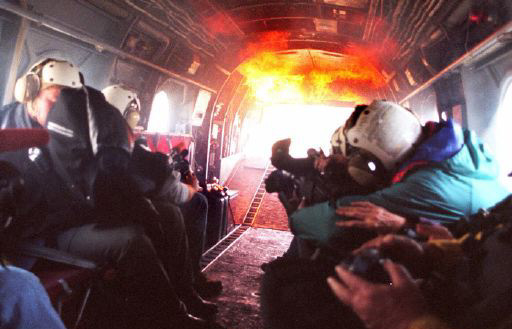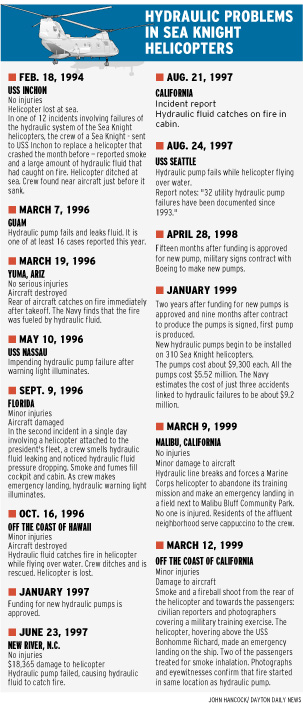 ORVILLE MYERS/ASSOCIATED PRESS/MONTERAY HERALD
A SEA KNIGHT HELICOPTER carrying reporters and photographers off the USS Bonhomme Richard caught fire shortly after takeoff in March. The helicopter made an emergency landing back on the deck of the ship. Two people were treated for smoke inhalation.
ORVILLE MYERS/ASSOCIATED PRESS/MONTERAY HERALD
A SEA KNIGHT HELICOPTER carrying reporters and photographers off the USS Bonhomme Richard caught fire shortly after takeoff in March. The helicopter made an emergency landing back on the deck of the ship. Two people were treated for smoke inhalation. |
Problems can exist years
before fixes implemented
Sea Knight has history of hydraulic woes

|
©1999 Dayton Daily News
The fire burned out of control inside the CH-46 Sea Knight helicopter as Capt. Jack Estepp spotted the coastline seven miles away through the clear Hawaiian night.
"We started smelling something," he said. "Then the fire started. I didn't want to see anybody get hurt. These guys are my friends."
  |
What Estepp smelled on that October night in 1996 was leaking hydraulic fluid, a smell that had become familiar to many of the crews flying CH-46s
The Hawaii crash is one of at least 71 incidents spanning more than 11 years involving hydraulic problems in Sea Knight helicopters, the Navy and Marine Corps' medium-lift troop and cargo transport, capable of carrying up to 28 soldiers and passengers.
None of the incidents was fatal, but in several cases, like the one in Hawaii, crews barely escaped with their lives. At least three helicopters were destroyed.
And the problems continue.
On March 9 of this year, 11 years after the first hydraulic problem was reported, a Sea Knight made an emergency landing near Malibu Bluff Community Park, 200 feet above the coast and in the center of the city of Malibu, Calif.
Three days later, a Sea Knight carrying reporters and photographers off the USS Bonhomme Richard in California caught fire when an hydraulic line broke. Two people, one a TV anchor, were treated for smoke inhalation.
An 18-month Dayton Daily News examination found that the military's handling of the hydraulic failures on Sea Knight helicopters is typical of the way it handled numerous other mechanical failures in many types of aircraft: Problems dragged on until they became catastrophic.
"We have to make hard choices based on dollars and cents," said Marine Corps Col. Roger Dougherty, a former Sea Knight pilot and until June the director of aviation safety at the Naval Safety Center in Norfolk, Va. "If it's a high risk that's going to happen often, it gets fixed. That's the bottom line."
The Daily News examination found that problems such as those involving the Sea Knight hydraulic system often continue for months, years, even decades. Sometimes costly solutions aren't implemented until aircraft start falling from the sky or the death toll rises.
"The point is the system reacts, albeit slowly sometimes, to the requirements that we generate here," said Bill Mooberry, executive director of the Naval Safety Center in Norfolk, Va. "It doesn't react slowly simply because it's unresponsive. It's simply that the facts are that the process takes time and money and engineering and analysis and all that other stuff to get it fixed."
Unlike the Federal Aviation Administration, which monitors civilian aviation safety, the Naval Safety Center cannot mandate safety changes. It cannot issue fines. It cannot ground aircraft. It cannot force the service to install a safer part on an aircraft.
"The Navy makes the decisions," Mooberry said. "All we do is advise. I don't have the power here to enforce. . . . I have the power of moral persuasion.
"I can whine and pound on the desk and jump on people's tables and beat at the rugs and stuff like that to try to get their attention, but as far as the decisions about who does what to whom. . ., safety is part of it, but it's not the only part.
"I don't direct anything. Nobody here directs anything."